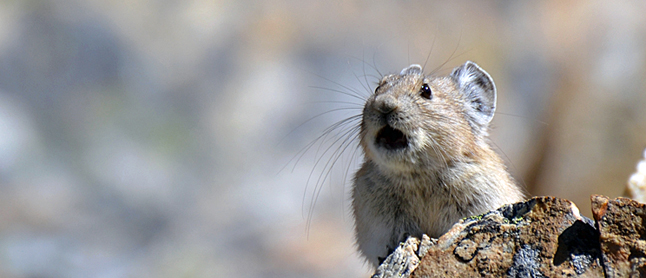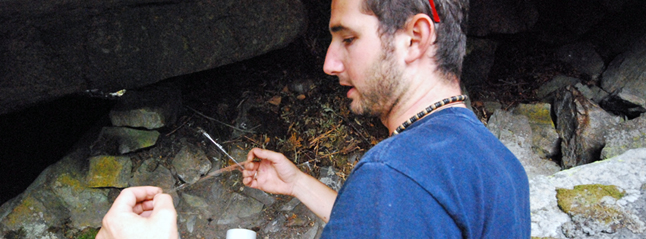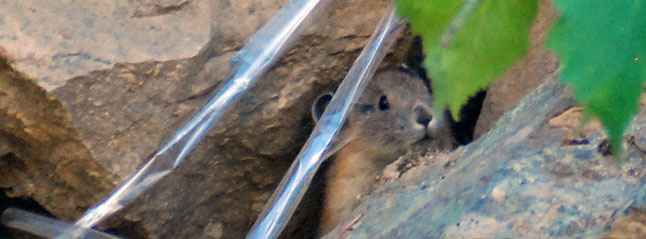UNBC researcher uses green techniques to study how climate change is affecting the evolution of a tiny BC animal
When climate change affects a region to the detriment of a local animal population, the species usually has three options: move to a more suitable region, remain and adapt, or go extinct. A researcher at the University of Northern British Columbia has found one tiny animal in BC dealing with climate change, which has opted to remain and appears, in an evolutionary sense, well equipped for a fight.

Media Download: The American pika, a small furry mammal with short limbs and rounded ears, is native to cold climates, mostly in Asia, North America, and parts of Eastern Europe.
“I decided to study the American pika (pronounced pee-kah) along BC’s Coast Mountains because we have observed a six degree temperature change along an elevation gradient from sea level to 1500 metres where the pika lives,” says Philippe Henry, an Assistant Professor of Ecosystem Science and Management at UNBC. “We know from previous studies of the pika that it is particularly sensitive to changes in temperature, which made it ideal for our study.”
The pika, a small furry mammal with short limbs and rounded ears, is native to cold climates, mostly in Asia, North America, and parts of Eastern Europe. Some species live on rocky mountain sides such as can be found in BC's Coast Mountain Range.
Dr. Henry’s research initially involved two contrasting hypotheses: that the climate is warming and climate change is happening, and that temperature-sensitive creatures like the pika would likely disperse to higher elevations in response to a warming climate.
“What we found was that there was basically no up-slope movement so there was no response to the changing climate in that sense,” says Dr. Henry, who recently worked on a documentary about pikas called “Survival” with the BBC, which will be released later this year. “This left us with two remaining options for the pika: it was either going to adapt, or it would go extinct at that location.”
According to Dr. Henry, and fortunately for the little pika, it appears to have all the necessary components for evolutionary adaptation.
“We looked at the conditions in the environment and the frequency of certain genetic markers to see if there was any indication of local adaptation,” says Dr. Henry. “We found signals that the creature has been adapting in its environment to climate change and that, in evolutionary terms, for the pika, this seems to be a more viable solution than moving to a more suitable environment.”
“If you have sufficient genetic variation, natural selection can act and the species may survive in that location with a physiological tolerance to warmer temperatures,” adds Dr. Henry. “The pika lives up to seven years, but they reproduce every year, so the generation time is one year, and natural selection may occur relatively rapidly in this system.”
In order to collect the pika’s genetic material for the study, Dr. Henry uses sustainable research methodologies that do as little harm to wildlife and the environment as possible. Using packing tape “hair snares,” and remote sensing cameras, Dr. Henry was able to collect more than enough pika data and DNA as he returned to the snares and collected up the tape.

Media Download: UNBC researcher Dr. Philippe Henry setting up a "hair snare" to collect pika hair and DNA.
“Researchers seeking samples from larger mammals such as grizzly bears will often use makeshift corrals with barbed wire that the animal must work its way through, often leaving tufts of fur and bits of skin and hide behind,” explains Dr. Henry. “We can’t do that with these little guys because they are going to poke an eye out and that’s obviously no good. Packing tape is light and very small. You can hike out into remote areas without carrying heavy traps.”

Media Download: Pika boo! A pika peers out of his burrow past a "hair snare" made of packing tape.
Dr. Henry and his collaborators are now monitoring pika populations in Banff and Yoho National Parks and using non-invasive techniques to look at sex ratios and population sizes. “The key for me is to have sustainable and safe interactions with wildlife as researchers. To me, there is a direct connection with this and UNBC’s status as Canada’s Green University.”